Economic Principles: Opportunity Cost and Budget Constraint Analysis
VerifiedAdded on 2022/08/22
|7
|930
|17
Homework Assignment
AI Summary
This assignment analyzes key economic principles, including trade-offs, opportunity cost, marginal thinking, and incentives. The student explores these concepts through practical examples, such as resource allocation and production decisions. The paper examines opportunity cost in production scenarios, calculating the cost of producing apples and pears. It also analyzes budget constraints, constructing a budget line and calculating opportunity costs for purchasing ATVs and snowmobiles. The assignment uses equations and graphical representations to illustrate economic concepts, providing a comprehensive understanding of how these principles apply to real-world decision-making. The document is available on Desklib, a platform offering valuable resources for students seeking assistance with their coursework.

Student’s Name
Institutional Affiliation
Professor
Date
Institutional Affiliation
Professor
Date
Paraphrase This Document
Need a fresh take? Get an instant paraphrase of this document with our AI Paraphraser
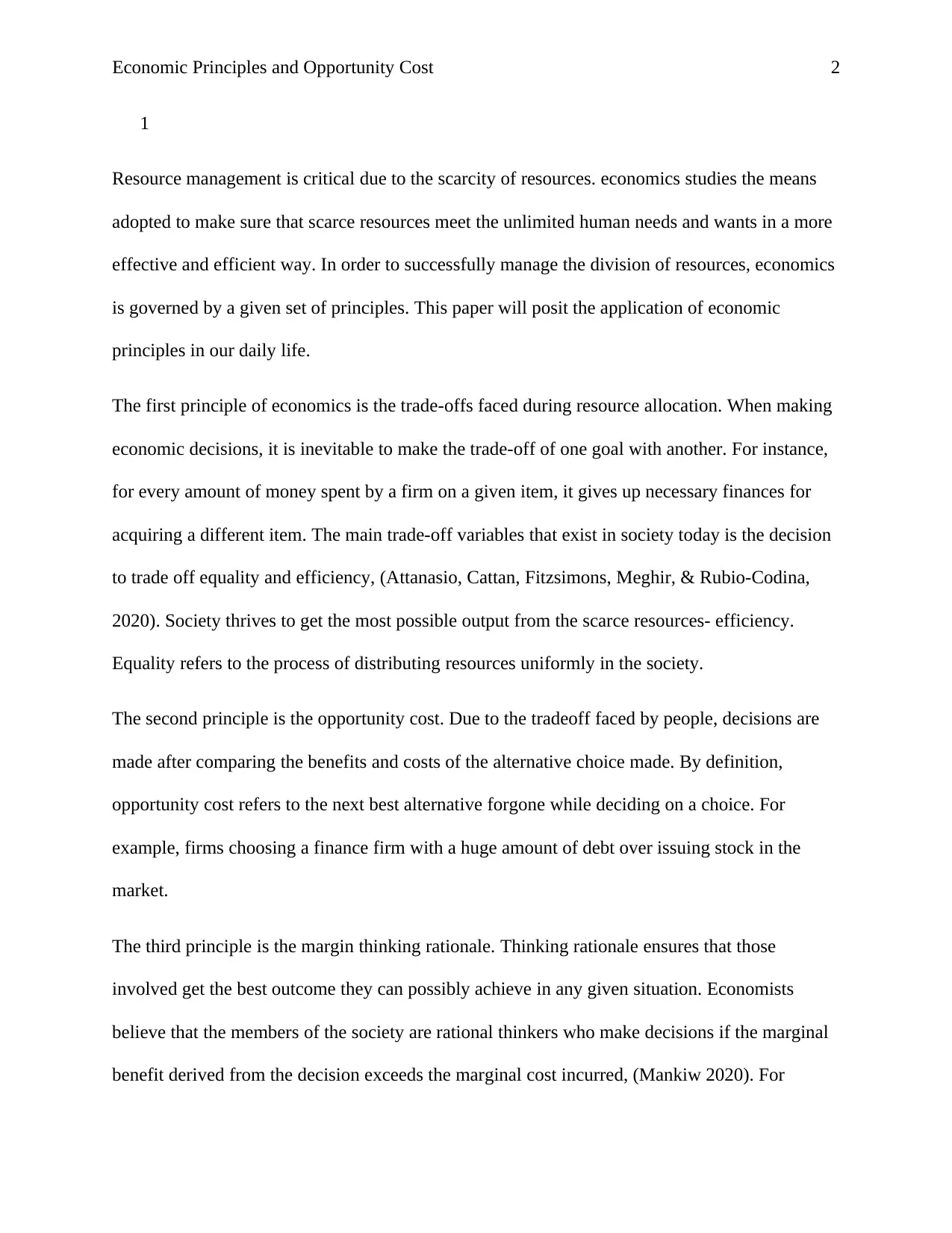
Economic Principles and Opportunity Cost 2
1
Resource management is critical due to the scarcity of resources. economics studies the means
adopted to make sure that scarce resources meet the unlimited human needs and wants in a more
effective and efficient way. In order to successfully manage the division of resources, economics
is governed by a given set of principles. This paper will posit the application of economic
principles in our daily life.
The first principle of economics is the trade-offs faced during resource allocation. When making
economic decisions, it is inevitable to make the trade-off of one goal with another. For instance,
for every amount of money spent by a firm on a given item, it gives up necessary finances for
acquiring a different item. The main trade-off variables that exist in society today is the decision
to trade off equality and efficiency, (Attanasio, Cattan, Fitzsimons, Meghir, & Rubio-Codina,
2020). Society thrives to get the most possible output from the scarce resources- efficiency.
Equality refers to the process of distributing resources uniformly in the society.
The second principle is the opportunity cost. Due to the tradeoff faced by people, decisions are
made after comparing the benefits and costs of the alternative choice made. By definition,
opportunity cost refers to the next best alternative forgone while deciding on a choice. For
example, firms choosing a finance firm with a huge amount of debt over issuing stock in the
market.
The third principle is the margin thinking rationale. Thinking rationale ensures that those
involved get the best outcome they can possibly achieve in any given situation. Economists
believe that the members of the society are rational thinkers who make decisions if the marginal
benefit derived from the decision exceeds the marginal cost incurred, (Mankiw 2020). For
1
Resource management is critical due to the scarcity of resources. economics studies the means
adopted to make sure that scarce resources meet the unlimited human needs and wants in a more
effective and efficient way. In order to successfully manage the division of resources, economics
is governed by a given set of principles. This paper will posit the application of economic
principles in our daily life.
The first principle of economics is the trade-offs faced during resource allocation. When making
economic decisions, it is inevitable to make the trade-off of one goal with another. For instance,
for every amount of money spent by a firm on a given item, it gives up necessary finances for
acquiring a different item. The main trade-off variables that exist in society today is the decision
to trade off equality and efficiency, (Attanasio, Cattan, Fitzsimons, Meghir, & Rubio-Codina,
2020). Society thrives to get the most possible output from the scarce resources- efficiency.
Equality refers to the process of distributing resources uniformly in the society.
The second principle is the opportunity cost. Due to the tradeoff faced by people, decisions are
made after comparing the benefits and costs of the alternative choice made. By definition,
opportunity cost refers to the next best alternative forgone while deciding on a choice. For
example, firms choosing a finance firm with a huge amount of debt over issuing stock in the
market.
The third principle is the margin thinking rationale. Thinking rationale ensures that those
involved get the best outcome they can possibly achieve in any given situation. Economists
believe that the members of the society are rational thinkers who make decisions if the marginal
benefit derived from the decision exceeds the marginal cost incurred, (Mankiw 2020). For
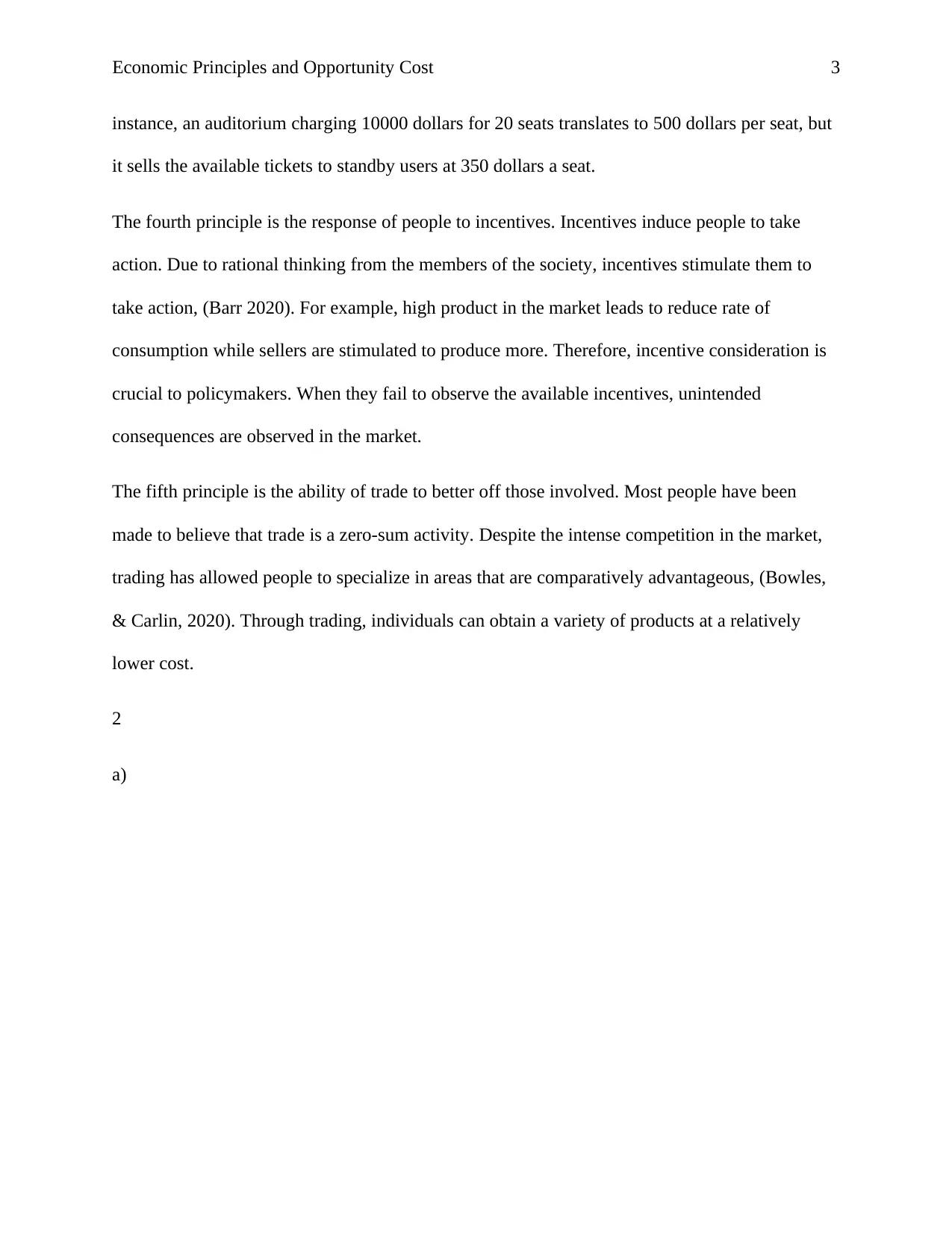
Economic Principles and Opportunity Cost 3
instance, an auditorium charging 10000 dollars for 20 seats translates to 500 dollars per seat, but
it sells the available tickets to standby users at 350 dollars a seat.
The fourth principle is the response of people to incentives. Incentives induce people to take
action. Due to rational thinking from the members of the society, incentives stimulate them to
take action, (Barr 2020). For example, high product in the market leads to reduce rate of
consumption while sellers are stimulated to produce more. Therefore, incentive consideration is
crucial to policymakers. When they fail to observe the available incentives, unintended
consequences are observed in the market.
The fifth principle is the ability of trade to better off those involved. Most people have been
made to believe that trade is a zero-sum activity. Despite the intense competition in the market,
trading has allowed people to specialize in areas that are comparatively advantageous, (Bowles,
& Carlin, 2020). Through trading, individuals can obtain a variety of products at a relatively
lower cost.
2
a)
instance, an auditorium charging 10000 dollars for 20 seats translates to 500 dollars per seat, but
it sells the available tickets to standby users at 350 dollars a seat.
The fourth principle is the response of people to incentives. Incentives induce people to take
action. Due to rational thinking from the members of the society, incentives stimulate them to
take action, (Barr 2020). For example, high product in the market leads to reduce rate of
consumption while sellers are stimulated to produce more. Therefore, incentive consideration is
crucial to policymakers. When they fail to observe the available incentives, unintended
consequences are observed in the market.
The fifth principle is the ability of trade to better off those involved. Most people have been
made to believe that trade is a zero-sum activity. Despite the intense competition in the market,
trading has allowed people to specialize in areas that are comparatively advantageous, (Bowles,
& Carlin, 2020). Through trading, individuals can obtain a variety of products at a relatively
lower cost.
2
a)
⊘ This is a preview!⊘
Do you want full access?
Subscribe today to unlock all pages.

Trusted by 1+ million students worldwide
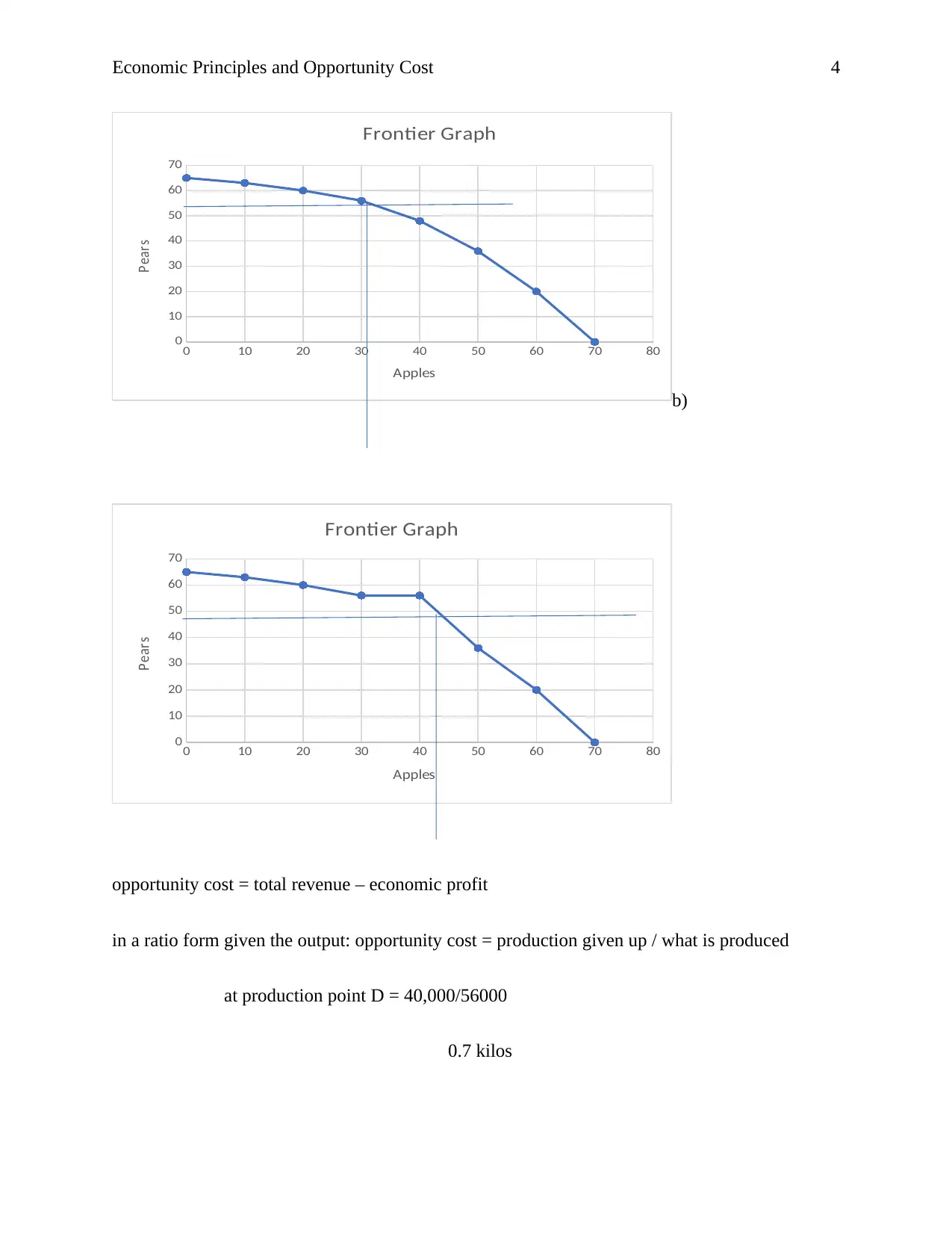
Economic Principles and Opportunity Cost 4
b)
0 10 20 30 40 50 60 70 80
0
10
20
30
40
50
60
70
Frontier Graph
Apples
Pears
opportunity cost = total revenue – economic profit
in a ratio form given the output: opportunity cost = production given up / what is produced
at production point D = 40,000/56000
0.7 kilos
0 10 20 30 40 50 60 70 80
0
10
20
30
40
50
60
70
Frontier Graph
Apples
Pears
b)
0 10 20 30 40 50 60 70 80
0
10
20
30
40
50
60
70
Frontier Graph
Apples
Pears
opportunity cost = total revenue – economic profit
in a ratio form given the output: opportunity cost = production given up / what is produced
at production point D = 40,000/56000
0.7 kilos
0 10 20 30 40 50 60 70 80
0
10
20
30
40
50
60
70
Frontier Graph
Apples
Pears
Paraphrase This Document
Need a fresh take? Get an instant paraphrase of this document with our AI Paraphraser
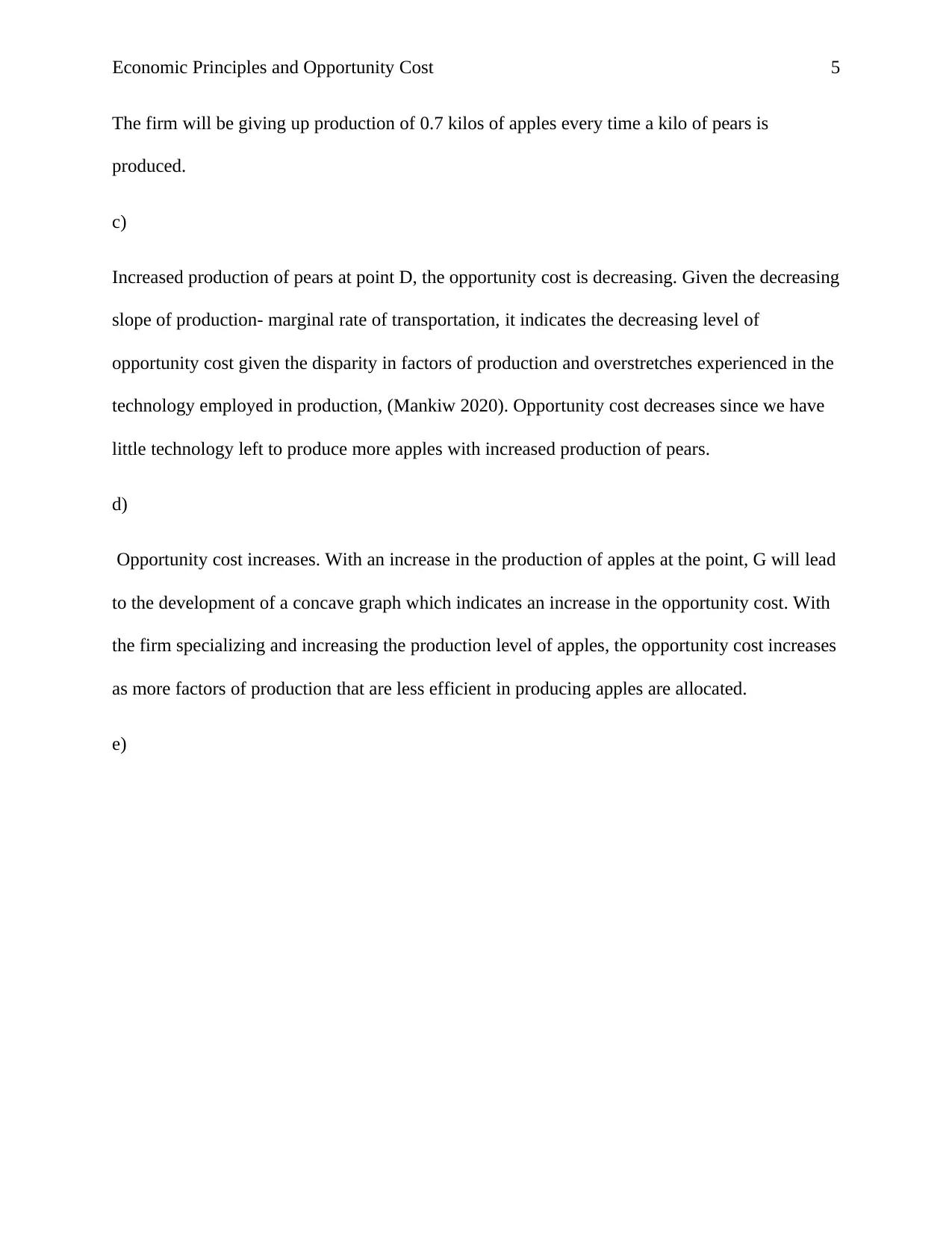
Economic Principles and Opportunity Cost 5
The firm will be giving up production of 0.7 kilos of apples every time a kilo of pears is
produced.
c)
Increased production of pears at point D, the opportunity cost is decreasing. Given the decreasing
slope of production- marginal rate of transportation, it indicates the decreasing level of
opportunity cost given the disparity in factors of production and overstretches experienced in the
technology employed in production, (Mankiw 2020). Opportunity cost decreases since we have
little technology left to produce more apples with increased production of pears.
d)
Opportunity cost increases. With an increase in the production of apples at the point, G will lead
to the development of a concave graph which indicates an increase in the opportunity cost. With
the firm specializing and increasing the production level of apples, the opportunity cost increases
as more factors of production that are less efficient in producing apples are allocated.
e)
The firm will be giving up production of 0.7 kilos of apples every time a kilo of pears is
produced.
c)
Increased production of pears at point D, the opportunity cost is decreasing. Given the decreasing
slope of production- marginal rate of transportation, it indicates the decreasing level of
opportunity cost given the disparity in factors of production and overstretches experienced in the
technology employed in production, (Mankiw 2020). Opportunity cost decreases since we have
little technology left to produce more apples with increased production of pears.
d)
Opportunity cost increases. With an increase in the production of apples at the point, G will lead
to the development of a concave graph which indicates an increase in the opportunity cost. With
the firm specializing and increasing the production level of apples, the opportunity cost increases
as more factors of production that are less efficient in producing apples are allocated.
e)
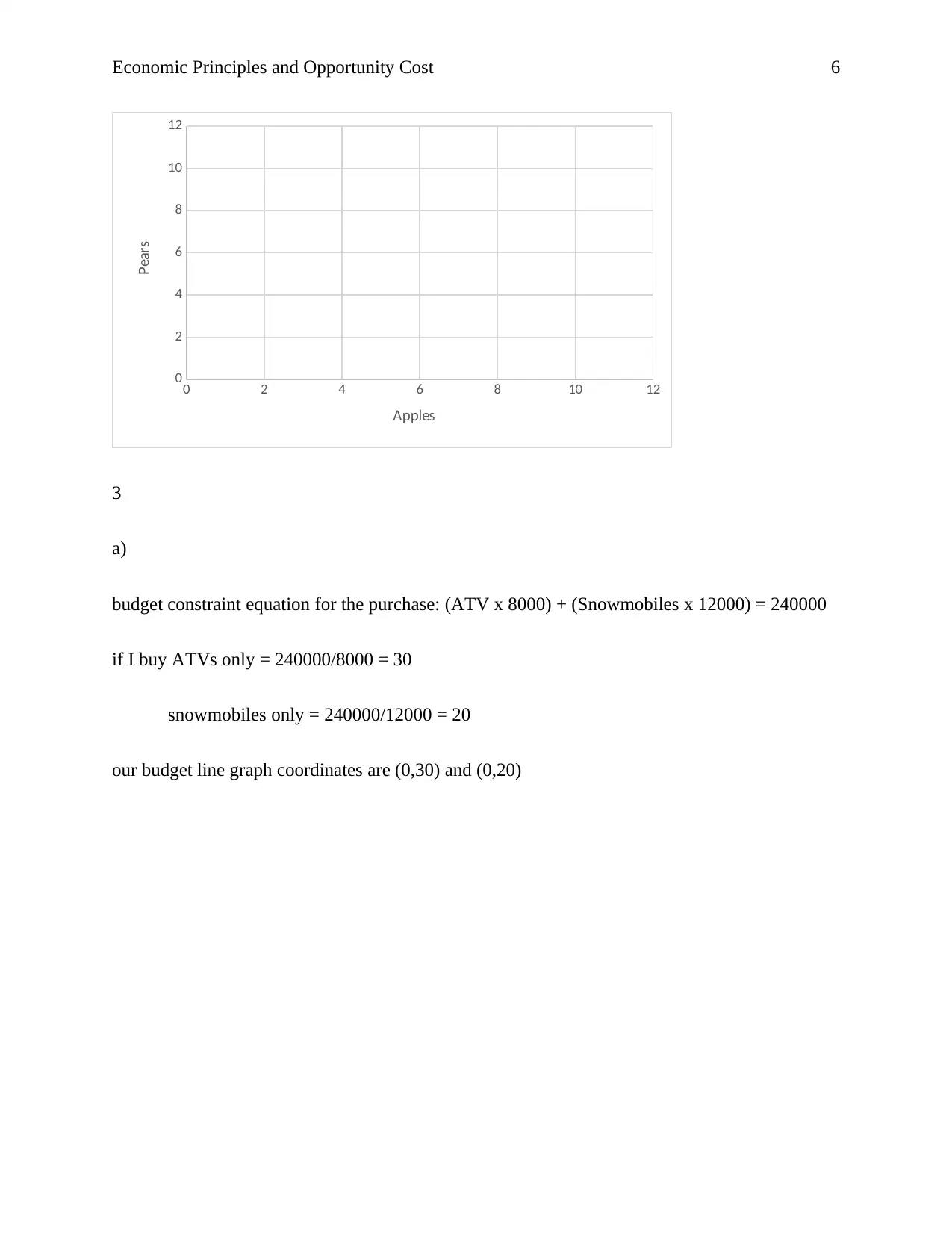
Economic Principles and Opportunity Cost 6
0 2 4 6 8 10 12
0
2
4
6
8
10
12
Apples
Pears
3
a)
budget constraint equation for the purchase: (ATV x 8000) + (Snowmobiles x 12000) = 240000
if I buy ATVs only = 240000/8000 = 30
snowmobiles only = 240000/12000 = 20
our budget line graph coordinates are (0,30) and (0,20)
0 2 4 6 8 10 12
0
2
4
6
8
10
12
Apples
Pears
3
a)
budget constraint equation for the purchase: (ATV x 8000) + (Snowmobiles x 12000) = 240000
if I buy ATVs only = 240000/8000 = 30
snowmobiles only = 240000/12000 = 20
our budget line graph coordinates are (0,30) and (0,20)
⊘ This is a preview!⊘
Do you want full access?
Subscribe today to unlock all pages.

Trusted by 1+ million students worldwide
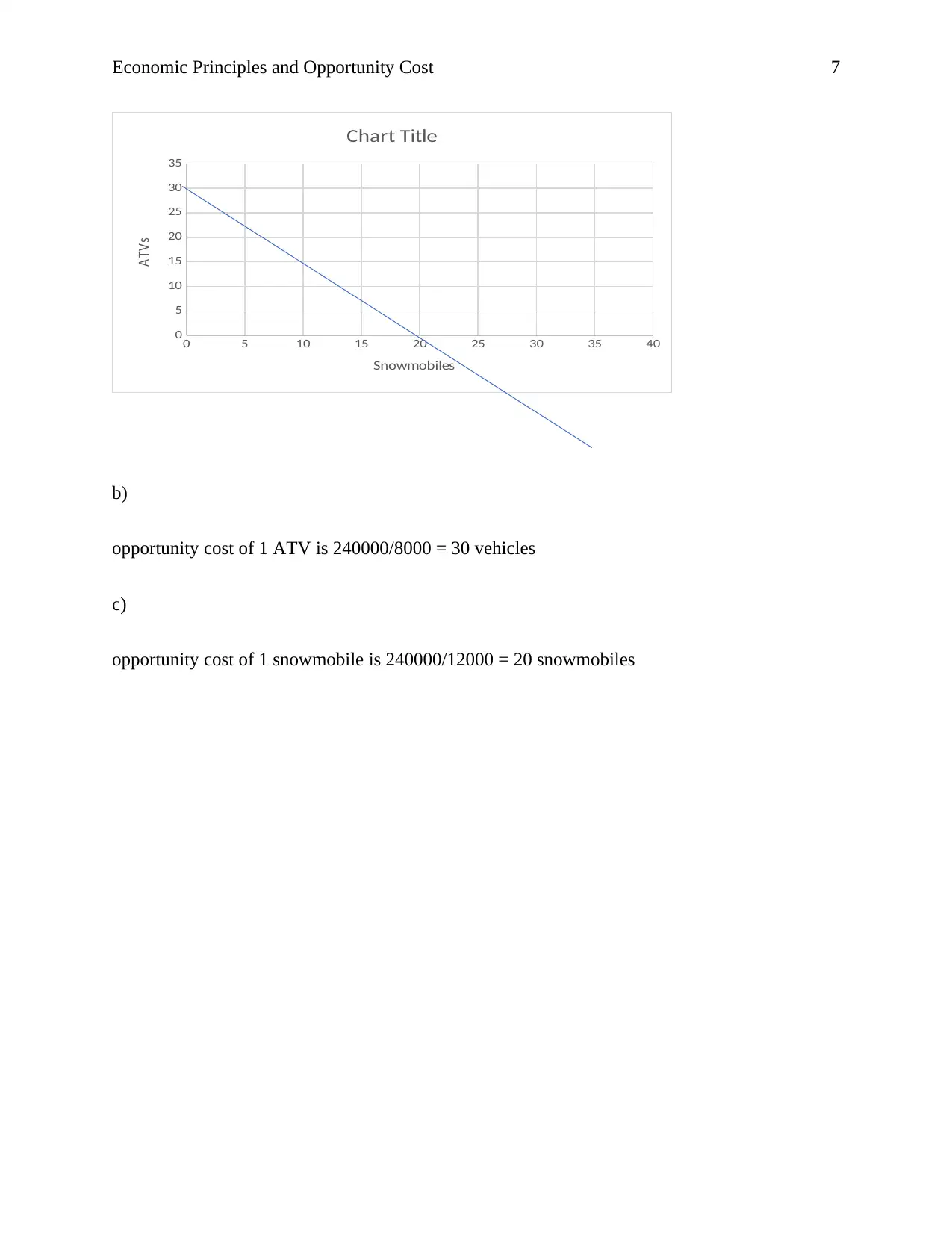
Economic Principles and Opportunity Cost 7
0 5 10 15 20 25 30 35 40
0
5
10
15
20
25
30
35
Chart Title
Snowmobiles
A TVs
b)
opportunity cost of 1 ATV is 240000/8000 = 30 vehicles
c)
opportunity cost of 1 snowmobile is 240000/12000 = 20 snowmobiles
0 5 10 15 20 25 30 35 40
0
5
10
15
20
25
30
35
Chart Title
Snowmobiles
A TVs
b)
opportunity cost of 1 ATV is 240000/8000 = 30 vehicles
c)
opportunity cost of 1 snowmobile is 240000/12000 = 20 snowmobiles
1 out of 7
Related Documents
Your All-in-One AI-Powered Toolkit for Academic Success.
+13062052269
info@desklib.com
Available 24*7 on WhatsApp / Email
![[object Object]](/_next/static/media/star-bottom.7253800d.svg)
Unlock your academic potential
Copyright © 2020–2025 A2Z Services. All Rights Reserved. Developed and managed by ZUCOL.





